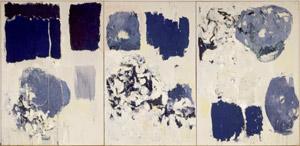"Les Bluets," 1973
A writer wrestles with a painting.
BY Lydia Davis
I start with the fact that Les Bluets (The cornflowers) is the painting I think of first when I think of one that has had particular significance in my life. Then I have to figure out why. I am not even certain that Les Bluets was the actual painting I saw. What I did see was a very large white and blue painting by Joan Mitchell in her studio more than forty-five years ago, and that is the one I am thinking of.
To get closer to the actual experience of seeing the painting, I first confirm or revise some of my memories of visiting her at Vétheuil, of her strong personality, of my life in Paris. Then I remember more, more than I need to, about where I was living, and how I worked at my writing, driving myself relentlessly to do better and more, with moments of pleasure, but often a hounding sense of obligation, a fear that if I did not work terribly hard something would catch up with me — perhaps the possibility that I did not need to be doing this.
I would take the train out of the city, with its closed spaces, its darkness, to the village of Vétheuil, sixty-nine kilometers to the north. A blue gate at the level of the street opened to a climb on foot to the house, a terrace before the "front door. The view from the hilltop was of a landscape managed, orderly: poplars by the winding river, and a village on the far bank. The grounds, the rooms in the house, and the mealtimes were also orderly, though I did not give much thought, then, to the value of order. Monet had once lived here, though at the base of the hill, in what was now the gardener’s cottage. His first wife, Camille, was buried in a cemetery beyond the garden.
On one visit I walked out to Mitchell’s studio to look at a painting. I don’t know if this was the first time I went into her studio. I liked the painting very much and thought there was no problem with the way I looked at it. It was what it was, shapes and colors, white and blue. Then I was told by Joan or someone else that it referred to the landscape here in Vétheuil, specifically to cornflowers. Whatever I had known or not known about painting before, this was a surprise to me, even a shock. Apparently I had not known that an abstract painting could contain references to subject matter. Two things happened at once: the painting abruptly went beyond itself, lost its solitariness, acquired a relationship to fields, to flowers; and it changed from something I understood into something I did not understand, a mystery, a problem.
Later I could try to figure it out: there had to be visual clues in the picture. Were all, or only some, of the elements in it clues? If the lighter, scattered, or broken areas of blue referred to cornflowers, what did the blocks of darker blue refer to, and the opulent white? Or were all the elements clues but some of them to private, unknow- able subjects? Was this a representation of an emotional response to cornflowers, or to a memory of cornflowers?
I like to understand things and tend to ask questions of myself or another person until there is nothing left that I do not understand. At the time, in the midst of a period when I was training myself so hard in another kind of representation, and seeing more and more clearly into the subtlest workings of my language, I was confronted with this experience of opacity.
I had had other striking experiences of incomprehension, the most extended being the weeks I spent in an Austrian first-grade class listening to the German language, before it began to change slowly, a fragment at a time, to something I could understand. Years later, when translating French texts into English, I struggled so hard with the meaning of certain complex sentences that I was sure I felt this struggle physiologically inside my brain—the little currents of electricity sparked, traveled, leaped forward against the problem, fell back, leaped again from a different side, failed. But this experience caught me unprepared, in its novel form — no words, but three panels of blue and white.
Eventually I began to find answers to my questions, but they were not complete answers, and after a time I did not feel the need for complete answers, because I saw that part of the force of the painting was that it continued to elude explanation. I became willing to allow aspects of the painting to remain mysterious, and I became willing to allow aspects of other problems to remain unsolved as well, and it was this new tolerance for, and then satisfaction in, the unexplained and unsolved that marked a change in me.
Even now, just by remaining so mysteriously fixed in my memory, the painting poses a question that, once again, remains even after I have attempted to answer it, and that is, not how does the painting work, but how does the memory of the painting work?
Copyright © 1996 by Lydia Davis. First appeared in Artforum, January 1996. Reprinted by permission of the author.
Lydia Davis is a short story writer, novelist, and translator. She is the author of six collections of short stories, including Can’t and Won’t (2014) and The Collected Stories of Lydia Davis (2009); one novel, The End of the Story (1995); and a collection of nonfiction, Essays One (2019), which was a finalist for the National Book Critics Circle Award. Her collection Varieties of Disturbance (2007...



